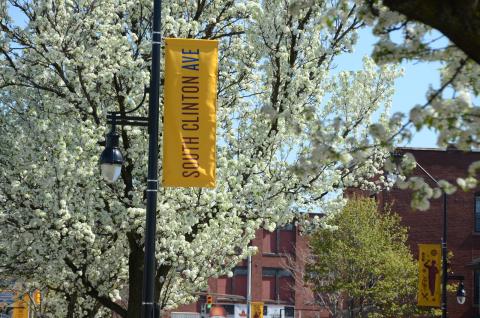Speed Hump Procedure
If you think speed is a factor on your street and are interested in participating in the process to apply for speed humps, please follow the instructions below.
The following multi-step speed hump procedure is used to approve future speed hump locations in the City of Rochester:
- Letter of request
- In-house evaluation of street functional classification and geometric features;
- Traffic study (collection and evaluation of traffic volume and speed data);
- Consideration of other factors; and,
- Receipt and verification of a 75% petition.
Letter of Request
The first step in the speed hump process is to submit a letter requesting speed humps on your street. Please send a letter of request, co-signed by a neighbor, to:
Holly E. Barrett, P.E.
City Engineer
City Hall, 30 Church Street, Room 300B
Rochester, NY 14614
In-House Evaluation
The first evaluation involves the screening of requested speed hump locations based on street geometric features and functional classification. Should the candidate street not meet these initial criteria, the City Engineer will deny the request for speed humps. The criteria for this evaluation are:
- The candidate street must be classified as a Local street in the Federal Highway Administration’s Functional Classification System. The purpose of the speed hump program is to discourage traffic and speeding on local streets. Accordingly, speed humps will not be permitted on any Collector, Minor Arterial, or Principal Arterial streets.
- The street must be “primarily residential” with at least two-thirds (66%) of the affected street frontage being in residential zoning districts as defined on the City’s Zoning map.
- The street must NOT be on a “primary” or routine emergency vehicle or public transit bus route. RTS bus routes and hospital, fire station, and police station locations will be used in this criteria.
- The street width must be less than 40' wide to indicate the street is not a wide arterial street.
- The street must have a grade of 6% or less approaching the hump location to avoid drainage problems and ensure safe vehicle operations.
- The street must have no parallel local residential streets. If there are parallel local residential streets, the placement of speed humps could merely shift traffic to the adjacent street(s). If parallel local residential streets exist, a multi-street request may be considered if accompanied by evidence of support from all streets involved.
- The candidate street should have a minimum distance of 800 feet between existing stop signs or traffic signals. Streets with many stop controls would already cause the slowing of traffic, although not necessarily slow traffic between the controls.
Traffic Study
If the street meets the initial screening, a traffic study to obtain vehicular speed and volume data will be undertaken and its results compared to the following criteria:
- The street must have a minimum average daily traffic (ADT) volume of 500; volumes of less than 500 indicate the street is serving as a true local residential street with minimal disruption to the neighborhood.
- On streets with ADT volumes between 500 and 3,500, at least 40% of the traffic in at least one direction must be traveling at or above the posted speed limit; on streets with ADT volumes greater than 3,500, at least 50% of the traffic in at least one direction must be traveling at or above the posted speed limit.
- On streets with ADT volumes between 500 and 3,500, the 85th Percentile Speed must be at least 35 MPH (i.e. 85% of the traffic must be traveling at or below 35 MPH) in at least one direction; on streets with ADT volumes greater than 3,500, the 85th Percentile Speed must be at least 40 MPH in at least one direction.
- If the street is immediately adjacent to property of an elementary school, City recreation center, or public park, at least 30% of the traffic must be traveling at or above the posted speed limit and the 85th Percentile Speed must be at least 31 MPH.
- There must be a minimum stopping sight distance of 300' at the humps to insure safe visibility of slowing vehicles.
Should the candidate street(s) not meet the above traffic speed and volume requirements, the City Engineer will deny the request for speed humps. Once a speed count is conducted on a given street, it will not be revisited for a minimum of three years unless known changes have taken place that may have significantly altered traffic conditions on the street (e.g., land use/development, street rehabilitation/reconstruction, etc.).
Consideration of Other Factors
If the street meets the above requirements, the last evaluation is the consideration of “other” factors which could further support or detract from the candidate site. These criteria include:
- History of accidents clearly related to speeding
- Adequate street lighting and drainage, and
- Other factors deemed appropriate by the City Engineer
Petition
If the above technical factors are met, then citizen support for the project must be demonstrated through a petition showing 75% support of occupied properties on the affected street(s). Once a 75% petition has been received and verified, the request will be ranked against others according to the severity of speeding (i.e., % over the posted speed limit). Those streets ranked highest would be first to receive speed humps as budgeted funds and staff resources permit.
Download the Procedure
Sharing the information with neighbors? Download the pdf.






